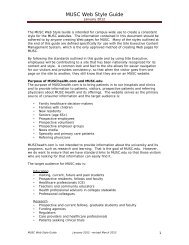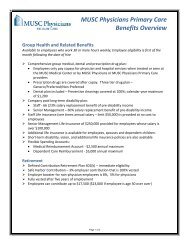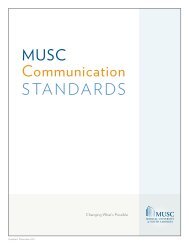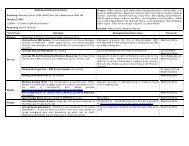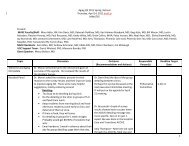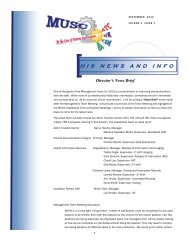BIS Monitoring Guideline - Medical Center Intranet
BIS Monitoring Guideline - Medical Center Intranet
BIS Monitoring Guideline - Medical Center Intranet
Create successful ePaper yourself
Turn your PDF publications into a flip-book with our unique Google optimized e-Paper software.
GUIDELINES FOR <strong>BIS</strong><br />
MONITORING TECHNOLOGY<br />
UTILIZATION IN THE HVC<br />
Owner: HVC Originated: 1/2006<br />
Location / File name:<br />
Reviewed:<br />
Legal Review:<br />
Revised:<br />
PURPOSE: Provide guidelines for <strong>BIS</strong> <strong>Monitoring</strong> Utilization in the Heart and Vascular <strong>Center</strong><br />
GUIDELINES:<br />
Indications for Use:<br />
<strong>BIS</strong> monitoring should be considered for the following patients:<br />
1. Mechanical Ventilator Therapy<br />
●Utilize <strong>BIS</strong> monitoring to assure sedation level is appropriate for the anticipated<br />
progression of ventilator therapy.<br />
2. Sedation level under which the patient cannot be assessed clinically<br />
●i.e. moderate to deep states of sedation<br />
●<strong>BIS</strong> monitor is used to guide interventions to minimize potential awareness, pain,<br />
anxiety or over sedation...<br />
3. Other patients as identified by specific physician order.<br />
PROCEDURE:<br />
Initiation of <strong>BIS</strong> <strong>Monitoring</strong>:<br />
<strong>BIS</strong> monitoring use may be nurse-initiated. <strong>BIS</strong> monitoring does not require a physician order.<br />
Implementing <strong>BIS</strong> <strong>Monitoring</strong>:<br />
Sensors have a 12-month shelf-life with the expiration date on the sensor package.<br />
Documentation Standards:<br />
The <strong>BIS</strong> Numeric Region or <strong>BIS</strong> index score will be documented on the Moderate Conscious<br />
Sedation flow sheet with the vital signs prior to patient stimulation and every 10 -15 minutes during<br />
the procedure. <strong>BIS</strong> Value is 0 to 100.<br />
0 = Flat line<br />
20 = Burst suppression<br />
60 = Low probability of explicit recall<br />
80 = Responds to loud commands<br />
100 = Wide awake<br />
<strong>Guideline</strong>s for <strong>BIS</strong> <strong>Monitoring</strong> Utilization in the Heart and Vascular <strong>Center</strong><br />
Page 1 of 2
The following sensor values should be considered when assessing the validity of the <strong>BIS</strong> index score<br />
but does not have to be recorded on the nursing record.<br />
●Signal Quality Index (SQI):<br />
Indicates quality of EEG signal over the last 63 seconds<br />
Check Sensor skin contact if SQI decreases<br />
●Electromyograph (EMG):<br />
Indicates presence of muscle activity or other high-frequency artifacts (oscillating ventilator modes,<br />
convective warming blanket, fluid warmer, oscillating air mattress)<br />
<strong>BIS</strong> value is optimal when EMG is absent of minimal, increased EMG may elevate the <strong>BIS</strong> value.<br />
EMG may occur as a result of pain, lightening sedation, and/or NMB wearing off.<br />
●Suppression Ratio Value (SR):<br />
Indicates the % of time in the last 63 seconds that the EEG signal is suppressed, (↑SR = ↓ <strong>BIS</strong> and vice<br />
versa). Helpful for monitoring the level of EEG suppression during drug-induced coma management.<br />
●Burst Count (Bursts/min):<br />
Another method of quantifying suppression that provides a measure of the number of EEG bursts per minute. A<br />
parameter (in addition to the SR) that indicates the percent of time over the last minute that the EEG is suppressed.<br />
Also helpful for monitoring the level of EEG suppression during drug-induced coma management.<br />
Considerations for <strong>BIS</strong> interpretation in the HVC:<br />
1. Clinical judgment should always be used when interpreting the <strong>BIS</strong> in conjunction with other<br />
available clinical signs.<br />
2. <strong>BIS</strong> readings should be interpreted in response to stimulation, and in the context of patient<br />
status and treatment plan.<br />
3. Patient movement (EMG) may occur with low <strong>BIS</strong> values.<br />
4. Patient movement (EMG) may indicate inadequate analgesic level.<br />
5. Artifacts and poor signal quality (SQI) may lead to unreliable <strong>BIS</strong> values. Potential artifacts<br />
may be caused by poor skin contact, muscle activity or rigidity, head and body motion,<br />
sustained eye movements, excessive interference (nerve stimulators, warming devices, air<br />
mattresses, etc.) Check sensor adherence and reprep sensor circles, review analgesic timing,<br />
reposition other medical equipment, move away from interference.<br />
6. <strong>BIS</strong> values should be interpreted cautiously in patients with known neurological disorders, in<br />
those taking psychoactive medications and in children less than 1 year old.<br />
<strong>Guideline</strong>s for <strong>BIS</strong> <strong>Monitoring</strong> Utilization in the Heart and Vascular <strong>Center</strong><br />
Page 2 of 2






